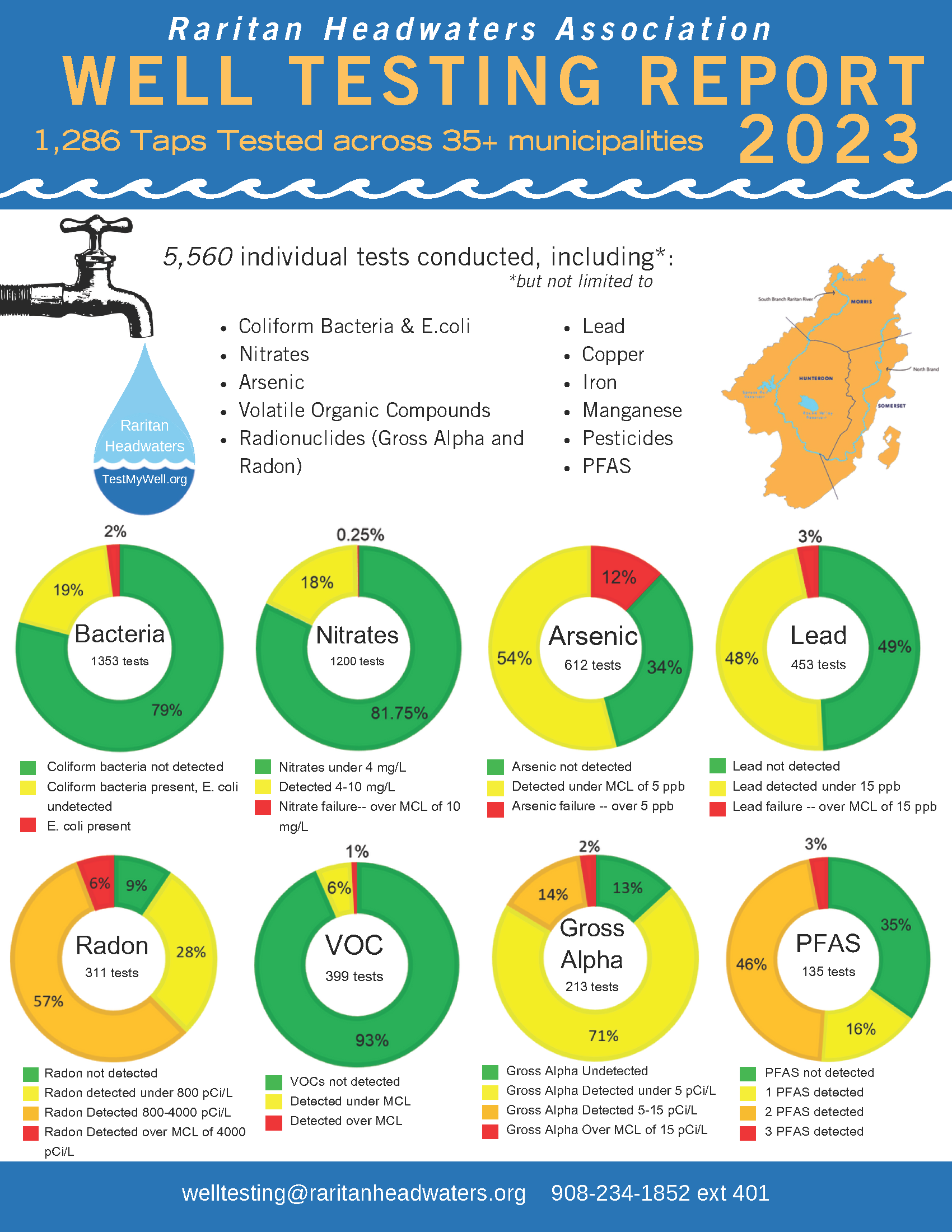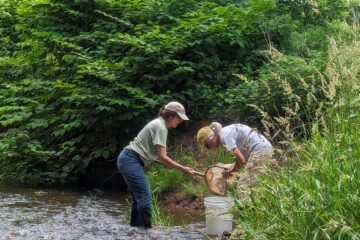In 2023, Raritan Headwaters conducted approximately 5500 individual well tests across 35 municipalities for a range of groundwater contaminants. RHA works closely with a state-certified lab to offer a variety of testing options at a reduced rate. The menu of available well tests is guided by the New Jersey Private Well Testing Act, and results are compared against federal and state exposure limits. While keeping results and data confidential, RHA is a valuable community resource for private residents concerned about the health of their drinking water.
The thought of testing or dealing with potential remediation can be daunting for residents, and because private well owners are not required to test their drinking water, they may be unknowingly exposed to contaminants over years. Poor water quality is not easily noticeable as most primary contaminants have no discernable taste, color, or smell. This is why RHA endeavors to make testing as simple, accessible, and affordable as possible. Well Test Program Manager Samantha LaRocca guides residents through every step of testing, from choosing crucial tests to understanding results and exploring treatment options.
Ever wonder what contaminants may be lurking in your drinking water? While fuel spillages and poorly managed industrial sites are obvious sources of pollution, everyday household items also contribute to an unhealthy water supply. Volatile Organic Compounds (VOCs), are a class of chemicals commonly found home products, such as paints, stains, pesticides, cosmetics, hairspray, and cleaning products. Ingesting these chemicals can contribute to vision and memory problems, as well as kidney, liver, and central nervous system damage. In 2023, VOCs were detected in 7% of the wells we tested.
Some contaminants occur naturally such as arsenic, a carcinogen found at different depths within bedrock throughout New Jersey. Parts of Hunterdon, Somerset, Mercer, and Middlesex counties fall within the geographic area of NJ known as the Piedmont Region, where arsenic is found in greater concentrations in groundwater. More than half of the wells tested by RHA in 2023 had detectable levels of arsenic, and around 12% had levels above the New Jersey Maximum Contaminant Level – although no amount of arsenic exposure is considered safe.
While the Safe Drinking Water Act of 1986 established standards for “lead-free” plumbing materials, it did not require the removal of existing lead pipes and fixtures. This means many homes built before 1986 may still contain lead components, potentially contaminating their drinking water. In 2023, approximately 51% of residents who tested their water with RHA found some level of lead contamination. Lead and copper can leach from pipes, solder, or fixtures as water travels through plumbing inside the home, an issue that may be exacerbated by acidic water, or water with higher concentrations of salt. Lead exposure is particularly dangerous for young children as it impairs healthy brain development, but even for adults, lead buildup in the body can be harmful to every organ. Whether your home relies on a private well or public water supply, testing for lead is vital, especially for homes built before 1986.
Another contaminant commonly found in our watershed is radon, a naturally occurring gas that is produced by the decay of radioactive uranium. Radon exposure can occur through drinking water or breathing radon in the air. Ingestion of radon dissolved in water can lead to health effects like stomach cancer. Although there isn’t a federally mandated Maximum Contaminant Level for radon in water, the EPA has suggested a cap of 4000 pCi/L. New Jersey has contemplated imposing stricter limits, potentially as low as 800 pCi/L. In 2023, 62% of wells tested exhibited radon concentrations at or above 800 pCi/L.
Over the last several years, research has proven that PFAS, which stands for per- and poly-fluoroalkyl substances, is a serious health risk found in water supplies. PFAS earned the nickname “forever chemicals” because they do not break down in the body or environment. Since the 1940s, PFAS have been used extensively in consumer products like Teflon and Gore-Tex due to their ability to repel water, oil, and grease. The United States began to phase out the production and use of some PFAS chemicals in 2002. However, new types of PFAS continue to be created by the chemical industry. Rising concerns about PFAS health risks, coupled with RHA’s 2023 detection rate of 65%, make testing critical for private well owners.
Specific contaminants in drinking water can range from aesthetic concerns to serious health problems, especially for those with preexisting health conditions, pregnant women, and young children. Raritan Headwaters understands residents’ concerns and prioritizes raising awareness and educating the public. Well Test Program Manager Samantha LaRocca and Julia Cook, Well Test Program Assistant are ready to help. In addition to the seasonal Community Well Test events hosted in partnership with municipalities in the Upper Raritan Region, RHA offers testing year-round through the Flemington and Bedminster offices. To reach staff with questions or to order a kit, please call (908)-234-1852 ext. 401, or visit www.TestMyWell.org.
Together, we can safeguard our community’s health! Get your well tested and share the message – clean water matters.




